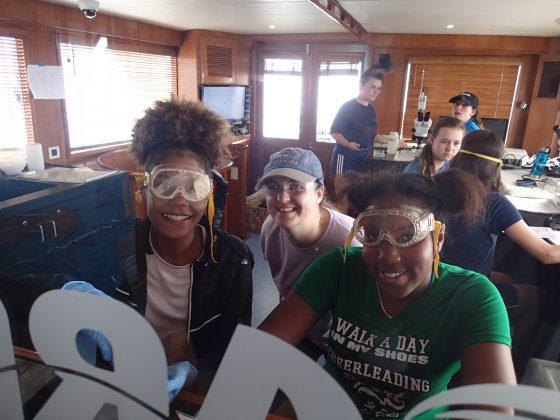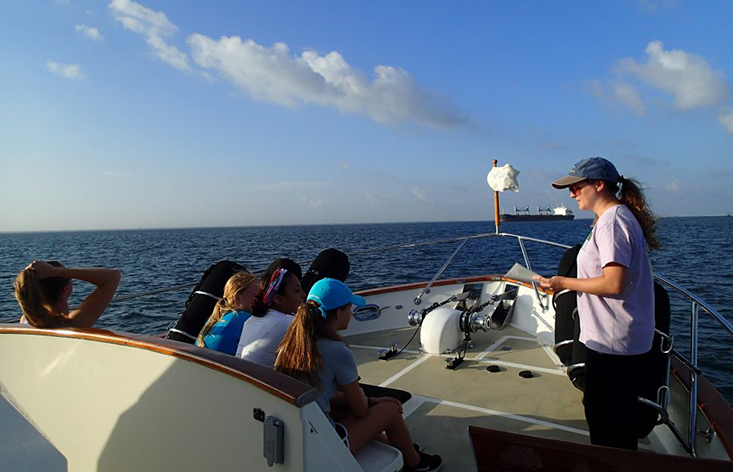Written by: Kyle Amergian
OCG campers arrived at the USF docks bright and early for their research cruise. As the sun rose, we boarded the R/V ANGARI ready for a day of sampling at sea! The girls headed up to the top deck to meet Captain Angela and the crew, and we started the day with a safety briefing and an introduction to sea-faring lingo as we learned the parts of a boat! As we pulled away from the dock, we went through our cruise plan together: Where would we go? What would we be doing? What equipment would we be using? We looked at a map of Tampa Bay and traced our cruise path, identifying which sites we would be visiting both inside and outside of the bay. We went through our objectives for the day, when suddenly a group of dolphins, including a mother and calf, were spotted off of the bow (Bonus points: what part of the boat is this? Our campers just learned!). There’s nothing like a marine megafauna sighting to start the day off right!
We arrived on station and got ready to begin sampling. The girls split into groups to complete the different sampling tasks. On cruise, we work together to gather different types of data which collectively paint a picture of the health of our bay! Outside, water sample collection began as the girls learned how to send a Niskin bottle over the side of the vessel. They gathered a water sample from the surface and from one meter above the bottom. On the other side of the boat, another group of campers gathered environmental data to tell us about the conditions on our site. The girls learned how to deploy a YSI and take abiotic measurements. Meanwhile, the girls inside the lab processed our water sample to determine what nutrients were present.

Our group was analyzing nutrients! We learned about why nutrients are important and what organisms use them (bonus points if you knew it was phytoplankton!). First, we needed a water sample. The group of girls deploying the Niskin bottle came in to tell us our sample was ready, and we headed outside to learn how to collect water from the Niskin bottles that they had just pulled up. Team work makes the dream work! After we had our sample, we headed inside to begin the nutrient tests. We used a HACH nutrient kit, which contains different reagents that we can use to determine the concentration nutrients in the water. Each test requires the girls to carefully measure out the amount of water needed and then mix a series of reagents into our water samples. The name of the game in nutrient testing is following the protocols for each reaction to produce a color change in the water! To test the levels of Nitrate and Phosphate, the girls complete a series of reactions that lead to a color change, then hold the sample up to the light in a color comparator to compare the sample to a color wheel that tells us the level of that nutrient present in the water. To test for the Carbon Dioxide, Dissolved Oxygen, and Alkalinity levels, the campers perform titrations, carefully adding reagents drop by drop until a color change occurs. Ocean chemistry is fun!
Each group of campers gets a chance to complete each task as we switch stations three times throughout the day. Between stations and after our third station, we get to sample for one more thing: life in the sea! Sediment grabs and plankton tows allow us to look at infaunal (living in the sediment) invertebrates and plankton that live in the water column (we might have even gotten a taste of the plankton!).
As we head back to the dock, we exchange our data and get ready to disembark. We’ve learned about how to collect the water samples, analyzed the chemistry of the water, assesed abiotic factors on our sites, and sampled life in the ocean. We thank the amazing R/V ANGARI crew and head off the boat. It was a great day out at sea!
